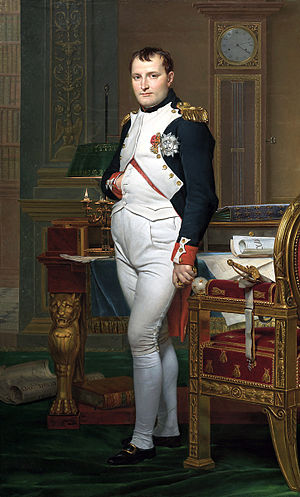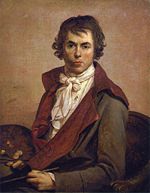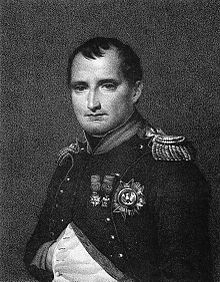- The Emperor Napoleon in His Study at the Tuileries
-
The Emperor Napoleon in His Study at the Tuileries 
Artist Jacques-Louis David Year 1812 Type Oil on canvas Dimensions 203.9 cm × 125.1 cm (80.3 in × 49.3 in) Location National Gallery of Art, Washington, D.C. The Emperor Napoleon in His Study at the Tuileries is an 1812 painting by Jacques-Louis David. It shows French Emperor Napoleon I in uniform in his study at the Tuileries Palace. Despite the detail, it is unlikely that Napoleon posed for the portrait.[1]
It was a private commission from the Scottish nobleman and admirer of Napoleon Alexander Hamilton, 10th Duke of Hamilton in 1811 and completed in 1812. Originally shown at Hamilton Palace, it was sold to Archibald Primrose, 5th Earl of Rosebery in 1882, from whom it was bought by the Samuel H. Kress Foundation in 1954, which deposited it in Washington DC's National Gallery of Art, where it now hangs.
Contents
Iconography
Vertical in format, it shows Napoleon standing, three-quarters, life size, wearing the uniform of a colonel of the Imperial Guard Foot Grenadiers (blue with white facings and red cuffs). He also wears his Légion d'honneur and Order of the Iron Crown decorations, along with gold epaulettes, white French-style culottes and white stockings. His face is turned towards the viewer and his right hand is in his jacket.
The office is on the right-hand first-floor of the Tuileries, with a wooden chair decorated in red velvet and gold embroidery and an Empire style desk on a sculpted stone base decorated with a lion's head. Piled on the desk are a pen, several books, dossiers and rolled papers. More rolled papers and a map are on the green carpet to the desk's left - on these papers is the painter's signature LVDci DAVID OPVS 1812. All this, along with Napoleons' unbuttoned cuffs, wrinkled stockings, disheveled hair, the flickering candles and the time on the clock (4.13am) are all meant to imply he has been up all night, writing laws such as the Code Napoleon - the word "Code" is prominent on the rolled papers on the desk. This maintains his new civil rather than heroic (as in Canova's Napoleon as Mars the Peacemaker) or military (as in David's own Napoleon Crossing the Alps) image, though the sword on the chair's armrest still refers back to his military successes. The fleurs-de-lys and heraldic bees also imply the stability of the imperial dynasty.
Second version
A second version painted by David, showing exactly the same scene but with Napoleon in his more everyday green mounted chasseurs uniform, was formerly in Prince Napoleon's collection and has since 1979 been in that of the château de Versailles.
Development
An examination of the original reveals that the artist revised the composition and details several times to balance the image, add iconography and tell a more complete story.
Brush strokes and texture indicate that an earlier version had Napoleon's upper body was flanked by two fluted columns about the width of the figure's torso. These strong vertical elements would have distracted from the central figure.
These columns were revised to a carved panel in shadow (on the viewer's left) and a clock with a large face (viewer's right) on level with and somewhat larger than the figure's face. The clock was later repainted with a smaller face moved up and to the right, with the clock body still covering the underlying column brush strokes.
These revisions greatly improved the compositional balance of the painting's upper section, reducing the impression of three vertical columns. They successfully moved the viewers focus to Napoleon's face and expression and away from the presumably accurate stature and middle-heavy build.
The change also allowed incorporating additional symbology, most notably the time (4:13).
Other revisions were added symbols on the table items and lower section, many painted over fleurs-de-lis which are conspicuously rare in the final image.
Notes
- ^ "The Emperor Napoleon in His Study at the Tuileries - Notes". National Gallery of Art. Accessed 21 August 2010.
References
- Antoine Schnapper David, 1748-1825, catalogue de l'exposition Louvre-Versailles 1989 ed. Réunion des musées nationaux, Paris, 1989 - Sur le tableau No 206 et 207 pages 474 - 477.
External links
Jacques-Louis David Works The Death of Marat · Portrait of Count Stanislas Potocki · Oath of the Horatii · The Death of Socrates · The Lictors Bring to Brutus the Bodies of His Sons · The Intervention of the Sabine Women · Napoleon at the Saint-Bernard Pass · The Coronation of Napoleon · Belisarius Begging for Alms · Portrait of Madame Récamier · Portrait of Pope Pius VII · Leonidas at Thermopylae · Napoleon in His Study · Portrait of Antoine-Laurent Lavoisier and his wife · Mars Being Disarmed by Venus · Andromache Mourning Hector Categories:
Categories:- 1812 paintings
- 19th-century portraits
- Collections of the National Gallery of Art
- Jacques-Louis David portraits
- Paintings of Napoleon
Wikimedia Foundation. 2010.


